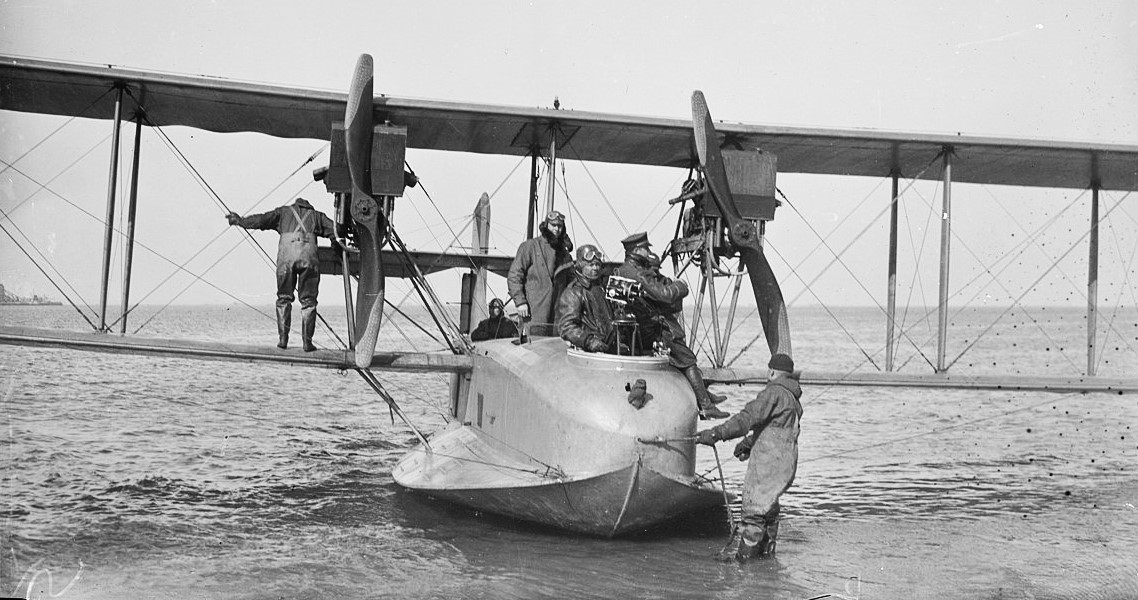Canadian Warplanes 2: Curtis H-16 Flying Boat
Curtis H-16 Flying Boat

(IWM Photo, Q 67581)
Curtiss H16 flying boat (Serial No. 8661), known as 'Old 61' at the Felixstowe Air Station. This aircraft flew the anti-submarine 'Spider Web' patrol 13 April 1917, an attempt to cover a key part of the southern North Sea with a network of aircraft.

(Naval History & Heritage Command, Photo S-551)
US Navy Curtiss H-16 flying boat (BuNo. A4060), flying over a coastline, 14 March 1918.
The Canadian Air Force received two former Royal Air Force H-16s (nick-named "Large Americas") as an Imperial Gift after the end of the First World War.
The Curtiss Model H was a family of classes of early long-range flying boats, the first two of which were developed directly on commission in the United States in response to the £10,000 prize challenge issued in 1913 by the London newspaper, the Daily Mail, for the first non-stop aerial crossing of the Atlantic. As the first aircraft having transatlantic range and cargo-carrying capacity, it became the grandfather development leading to early international commercial air travel, and by extension, to the modern world of commercial aviation. The last widely produced class, the Model H-12, was retrospectively designated Model 6 by Curtiss' company in the 1930s, and various classes have variants with suffixed letters indicating differences.
The Model H-16, introduced in 1917, represented the final step in the evolution of the Model H design. With longer-span wings, and a reinforced hull similar to the Felixstowe flying boats, the H-16s were powered by Liberty engines in U.S. Navy service and by Eagle IVs for the Royal Navy. These aircraft remained in service through the end of World War I. Some were offered for sale as surplus military equipment at $11,053 apiece (one third of the original purchase price.) Others remained in U.S. Navy service for some years after the war, most receiving engine upgrades to more powerful Liberty variants.
With the RNAS, H-12s and H-16s operated from flying boat stations on the coast in long-range anti-submarine and anti-Zeppelin patrols over the North Sea. A total of 71 H-12s and 75 H-16s were received by the RNAS, commencing patrols in April 1917, with 18 H-12s and 30 H-16s remaining in service in October 1918.
U.S. Navy H-12s were kept at home and did not see foreign service, but ran anti-submarine patrols from their own naval stations. Twenty aircraft were delivered to the U.S. Navy. Some of the H-16s, however, arrived at bases in the UK in time to see limited service just before the cessation of hostilities. Navy pilots disliked H-16 because, in the event of a crash landing, the large engines above and behind the cockpit were likely to break loose and continue forward striking the pilot. (Wikipedia)

(Library of Congress Photo)
Curtiss H-16 flying boat at Hampton Roads, 1 Jan 1915.
.jpg)
(Transportation Photo Collection)
Curtiss H-16 flying boat hull in the factory, circa 1917-1919. The Curtiss Aeroplane and Motor Company was founded by Glenn H. Curtiss in the early 1900s. To save the company from bankruptcy in the 1910s , Curtiss sold it to John N. Willys of the Overland Motor Company. With the onset of the Second World War the company moved its headquarters and most manufacturing activities to Buffalo, New York with a support operation in Toronto, Canada. The Curtiss Aeroplane and Motor Company made many successful aircraft and because of Curtiss' interest in water flying, it pioneered the designs for seaplanes and flying boats.
_H-16_at_NACA_Langley_in_1929.jpeg.jpeg)
(NASA Photo)
A Naval Aircraft Factory (Curtiss) H-16 at the Langley Aeronautical Laboratory at Hampton, Virginia (USA). The Naval Aircraft Factory H-16 flying boat, seen here on a beaching dolly on the Langley seaplane ramp, was one of 150 built by the Naval Aircraft Factory in Philadelphia, Pennsylvania (USA). Most H-16s built were made by Curtiss, so the type is more readily known under that name. The NACA performed hull pressure distribution tests at Langley during 1929.

(USN Photo)
US Navy Curtiss H-16 flying boat (BuNo. A4060), c1918.





